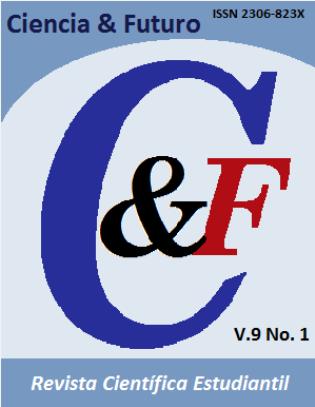Evaluating the clays from Centeno to be used in red ceramic in Moa municipality
Keywords:
red ceramic, clay, construction material, linear contraction, X-ray diffraction, bricksAbstract
Clayey materials were assessed in the new sector of Centeno, Moa municipality with and without glassy tuffs with belonging to companies from Sagua de Tánamo municipality to use it in the Industria Locales and the Construction enterprises. Two mixing of ceramics made with different dosages of clays were studied, as well as the factors that take part in the correct elaboration of the mixtures: grain size, drying conditions and cooking temperature. The technological parameters are the percentages of linear contraction, weight loss, water absorption, as well as the compressive strength expressed in MPa. The samples were also characterized by x-ray diffraction. The mixtures of the clays from Centeno with 10% of glassy tuffs were assessed for their use in manufacturing ceramic bricks at the construction industry in Moa municipality.Downloads
References
CHACÓN, M. 2016. Evaluación de mezclas de materiales arcillosos de la zona de Cayo Guam y arena sílice residual para su utilización en la industria cerámica. Ciencia & Futuro 6(1): 50-66.
DÍAZ, Y.; BETANCOURT, D. & MARTIRENA, F. 2011.
Influencia de la finura de molido del carbonato de calcio en las propiedades físico mecánicas y de durabilidad de los ladrillos de cerámica roja. Revista Ingeniería de Construcción 26(3): 269-283.
DÍAZ, A. 2015. Evaluación de mezclas de arcillas con adición de tobas vítreas para la fabricación de ladrillos cerámicos en Bayamo. Ciencia & Futuro 5(1): 20-35.
NJILA, T. 2010. Evaluación mineralógica semi-cuantitativa de las cortezas de meteorización no niquelíferas en la región nororiental de Cuba. Minería & Geología 26(4): 1-15.
RODRÍGUEZ, R. M.; BLANCO-MORENO, J. A.; PROENZA-FERNÁNDEZ, J. A. & OROZCO-MELGAR, G. 2001. Petrología de las rocas plutónicas de afinidad ofiolítica presentes en la zona de Cayo Grande (Macizo Ofiolítico Moa-Baracoa), Cuba Oriental. Minería & Geología 18(1): 14.
PÉREZ, Y. 2011. Evaluación de tobas vítreas y zeolitizadas de la provincia Holguín para su utilización como puzolana natural en la construcción. Ciencia & Futuro 1(4): 41-51.
POLL, L.; ALMENARES, R.; ROMERO, Y.; DÍAS, A. A.; LEYVA-RODRÍGUEZ, C. A. & MARTIRENA, J. 2016. Evaluación de la actividad puzolánica del material arcilloso del depósito La Delta, Moa, Cuba. Minería & Geología 32(1): 15-27.
SILEGA, D. & HERNÁNDEZ, Y. 2016. Potencialidades de las tobas zeolitizadas del yacimiento San Andrés para la obtención de aglomerantes ternarios. Ciencia & Futuro 6(4): 1-16.
Published
How to Cite
Issue
Section
Esta obra está bajo una Licencia Creative Commons Reconocimiento-NoComercial 4.0 Internacional
La Revista Ciencia & Futuro es una revista de acceso abierto, todo el contenido está disponible gratuitamente sin cargo para el usuario o su institución. Los usuarios pueden leer, descargar, copiar, distribuir, imprimir, buscar o vincular los textos completos de los artículos, o utilizarlos para cualquier otro fin lícito, sin pedir permiso previo al editor o al autor. Todo lo anterior, de acuerdo con la definición de BOAI de acceso abierto.
Los autores que publican en esta revista están de acuerdo con los siguientes términos: Licencia Creative Commons Atribución-NoComercial permite que el beneficiario de la licencia tenga el derecho de copiar, distribuir, exhibir y representar la obra y hacer obras derivadas para fines no comerciales siempre y cuando reconozca y cite la obra de la forma especificada por el autor o el licenciante. Los autores pueden establecer por separado acuerdos adicionales para la distribución no exclusiva de la versión de la obra publicada en la revista (por ejemplo, situarlo en un repositorio institucional o publicarlo en un libro), con un reconocimiento de su publicación inicial en esta revista. Se permite y se anima a los autores a difundir sus trabajos electrónicamente (por ejemplo, en repositorios institucionales o en su propio sitio web) antes y durante el proceso de envío, ya que puede dar lugar a intercambios productivos, así como a una citación más temprana y mayor de los trabajos publicados (Véase The Effect of Open Access) (en inglés). Lo anterior debe realizarse siempre sobre el artículo ya publicado por Ciencia & Futuro.
Los autores mantienen el control sobre la integridad de sus trabajos y el derecho a ser adecuadamente reconocidos y citados.
A los editores se les otorgan derechos no exclusivos para publicar y distribuir.



